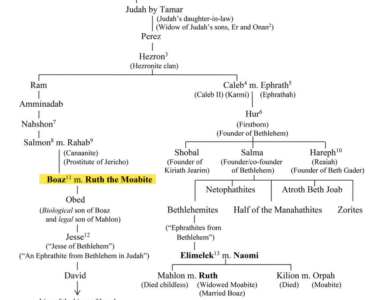 What does the Bible say about art? What is a biblical, systematic, and practical theology of aesthetics? What is the scriptural teaching about the passions that motivate us? How were we made for God’s delight? And, though sin and bondage plague our passions, how does God shape our fun, feelings, desires, and affections?
What does the Bible say about art? What is a biblical, systematic, and practical theology of aesthetics? What is the scriptural teaching about the passions that motivate us? How were we made for God’s delight? And, though sin and bondage plague our passions, how does God shape our fun, feelings, desires, and affections?
Bible Gateway interviewed David A. Covington about his book, A Redemptive Theology of Art: Restoring Godly Aesthetics to Doctrine and Culture (Zondervan, 2018).
What are godly aesthetics?
David A. Covington: God enjoys his own beautiful glory, so he also enjoys the reflection of his glory in his creation (“…behold, it was very good” Gen 1:31). He expresses revulsion, wrath, sorrow at that which twists, perverts, trammels the glory he loves. We see godly aesthetics at work when God’s delights and disgusts get worked back into his people (Matt 25:21).
Why do they need to be restored?
David A. Covington: We show by our lives that rebellion has distorted our entire pleasure palate. We need Bible wisdom and Holy Spirit help for our affections to grow more like our Lord’s, and so we can help others. God has long been working his tastes back into believers. Evangelicals, with our mixed feelings about feelings, either expect our taste for beauty to lead us to God, or away, or to be a sideshow to real ministry. We formulate doctrines of aesthetics reflecting these expectations, and we neglect the Bible’s teaching that our tastes, our affections, are fallen but destined for reunification with our restored reason and will, in Christ.
I’m convinced from Scripture, buttressed by personal experience, that our affections are neither all good nor inherently bad, nor are they ever neutral; instead, they’re redeemable. The Bible teaches a redemptive doctrine of aesthetics we have long neglected—just what we need to grow in grace and to help others.
What do you mean when you write, “pleasure and truth don’t always go hand in hand”?
David A. Covington: We default to compartmentalizing pleasure and truth. We rarely question the truth of our delights. We turn a blind eye to the pleasures that attend sound doctrine.
When Beauty and Truth show up together in Scripture, even in person, we tend to recognize only the one we were looking for, and we get twitchy. The religious builders got twitchy, rejecting the true cornerstone; it didn’t look right, didn’t fit their narrative.
God’s story of redemption, the Bible, is packed with God’s work to fix this through Jesus who draws us to him to see, love, and hate as he does—with him! Christians have seen God’s work in them to bring affections and truth together again in Jesus, the image and the word of God.
Explain your statement, “studying the Bible for aesthetics might yield fuller insights than studying it for art.”
David A. Covington: Studying the Bible for art is like trying to download an app from a cherry tree. For starters, we’d need search criteria; a definition of art. Does the Bible define art? Tough.
What about a cultural convention? That’s like liquid mercury—anyone can see it, but it’s hard to get hold of.
As a fallback, can we just distinguish Art from non-art? Tougher; Art philosophers love to push Art’s boundaries, bigger and bigger. If Art is everything, which Scripture passages speak about it? Scripture is full of the beautiful (and the ugly, too) that all hinges on who’s seeing it, and how and why. Now we’re talking the Bible’s language, and its story of aesthetic redemption opens in front of us.
How do “aesthetics in the Bible speak profoundly and always with change in mind”?
David A. Covington: God saw his goodness into creation, but our first parents preferred to find private pleasures there. God promised to restore shared aesthetics (Gen 1-3).
God designed the Wilderness Tabernacle with almost every kind of aesthetic appeal, but always for his own audience, often alone. He always intended his people to share his pleasures, but the sacrifice comes first, and it would take time; meanwhile, only one representative can get close to most of these beauties.
“Stolen water is sweet” to a fool (Pr 9:17); God, who knows our folly, has already called us to turn to him and become wise (Pr 9:4-6). His wisdom entails better pleasures, with some suffering, and then endless delights with him! Isaiah shouts God’s invitation, “Come, everyone who thirsts, come to the waters!” “Why do you spend your money for that which is not bread…? Listen diligently to me and eat what is good, and delight yourselves in rich food.”
Jesus displays pleasure in the most personal and God-centered expression, “[The Father] has not left me alone, for I always do the things that are pleasing to him.” (John 8:29). Jesus also hints at the divine pleasures coming to believers: “enter into the joy of your master” (Matt 25:21). Our aesthetically rich Bible speaks everywhere about believers’ tastes changing, growing godly.
What are the aesthetic effects of sin and of redemption?
David A. Covington: The top three effects of sin are: 1. Whatever we’re experiencing becomes about us, for us alone; we replace God as First Viewer, the Audience, the Evaluator. We become auto-aesthetic, just like we pretend to autonomy. 2. We insist on assessing beauty separately from truth and power/ethics so we can have our fun without noticing our lies and our shame. 3. Creation’s transparency is lost to us: we look at created things turned opaque, not through them at God. We lose breadth and clarity. We lose sensitivity. It takes more to delight us and to outrage us than it once did.
In Jesus the Father is pleased, but it took courage for him to become ugly enough to do it. We believers in Jesus share in his costly redemption, becoming “heirs of God and fellow heirs with Christ, provided we suffer with him, that we may also be glorified with him” (Rom 8:17). Jesus’ redemption of all the aesthetic effects of sin brings us into the very delights of God, higher and better than the delights our first parents despised.
What is a favorite Bible passage of yours and why?
David A. Covington: Luke 24:44-49 has caught fire for me lately. Here, Jesus actually summarizes the Old Testament for his disciples; it’s about him in three bullet points; actually his three-point “to-do” list: “Thus it is written, that the Christ should suffer and on the third day rise from the dead, and that repentance and forgiveness of sins should be proclaimed in his name to all nations, beginning from Jerusalem.” Jesus is unstoppably determined to fulfill all that was written about him. Two down, one to go. I’ve been asking him to show me especially how he fulfills the Psalms, the seed of all our music worship.
What are your thoughts about Bible Gateway and the Bible Gateway App and Bible Audio App?
David A. Covington: Thank you! I appreciate the introduction and look forward to profiting from the work of many, made so accessible! Thanks again!
Is there anything else you’d like to say?
David A. Covington: Thank you! A real privilege to be included in your effort. Readers who want more on biblical aesthetics might take interest in my article, “Can Beauty Lead Us to God?” (By Faith Magazine, forthcoming), summarizing one main theme from my book. They can also find me on Facebook and write to me directly with comments and questions at redemptivetheologyart@gmail.com. Thanks again!
A Redemptive Theology of Art is published by HarperCollins Christian Publishing, Inc., the parent company of Bible Gateway.
Bio: David A. Covington (MDiv, ThM, DMin, Westminster Theological Seminary) is a singer and songwriter—as well as a counselor, writer, and farmer. He studied art and music at UCLA, made several albums, and toured with his wife, Sharon, as Covington & Covington, singing and speaking at colleges, conferences, retreats, churches, and schools around the United States and in Russia. His musical interests drew him to study biblical aesthetics, first at L’Abri in Switzerland and then at Westminster Theological Seminary where his ThM focused on cultural apologetics and his DMin addressed biblical counseling in an aesthetics-driven age. David writes and counsels, and with Sharon performs, leads worship, and teaches. They also farm their homestead in the Sierra Nevada mountains.
Study the Bible without ponderous software by becoming a member of Bible Gateway Plus. Try it right now!
The post How Does God Redeem Our Feelings?: An Interview with David A. Covington appeared first on Bible Gateway Blog.











